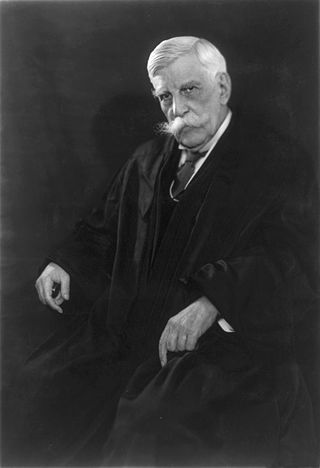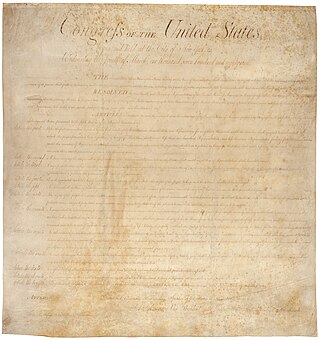Related Research Articles

Clear and present danger was a doctrine adopted by the Supreme Court of the United States to determine under what circumstances limits can be placed on First Amendment freedoms of speech, press, or assembly. The test was replaced in 1969 with Brandenburg v. Ohio's "imminent lawless action" test.
Brandenburg v. Ohio, 395 U.S. 444 (1969), is a landmark decision of the United States Supreme Court interpreting the First Amendment to the U.S. Constitution. The Court held that the government cannot punish inflammatory speech unless that speech is "directed to inciting or producing imminent lawless action and is likely to incite or produce such action". Specifically, the Court struck down Ohio's criminal syndicalism statute, because that statute broadly prohibited the mere advocacy of violence. In the process, Whitney v. California (1927) was explicitly overruled, and Schenck v. United States (1919), Abrams v. United States (1919), Gitlow v. New York (1925), and Dennis v. United States (1951) were overturned.
Gitlow v. New York, 268 U.S. 652 (1925), was a landmark decision of the United States Supreme Court holding that the Fourteenth Amendment to the United States Constitution had extended the First Amendment's provisions protecting freedom of speech and freedom of the press to apply to the governments of U.S. states. Along with Chicago, Burlington & Quincy Railroad Co. v. City of Chicago (1897), it was one of the first major cases involving the incorporation of the Bill of Rights. It was also one of a series of Supreme Court cases that defined the scope of the First Amendment's protection of free speech and established the standard to which a state or the federal government would be held when it criminalized speech or writing.
Breach of the peace or disturbing the peace, is a legal term used in constitutional law in English-speaking countries and in a public order sense in the several jurisdictions of the United Kingdom. It is a form of disorderly conduct.
First National Bank of Boston v. Bellotti, 435 U.S. 765 (1978), is a U.S. constitutional law case which defined the free speech right of corporations for the first time. The United States Supreme Court held that corporations have a First Amendment right to make contributions to ballot initiative campaigns. The ruling came in response to a Massachusetts law that prohibited corporate donations in ballot initiatives unless the corporation's interests were directly involved.
Sedition and seditious libel were criminal offences under English common law, and are still criminal offences in Canada. Sedition is overt conduct, such as speech and organization, that is deemed by the legal authority to tend toward insurrection against the established order: if the statement is in writing or some other permanent form it is seditious libel. Libel denotes a printed form of communication such as writing or drawing.
Virginia v. Black, 538 U.S. 343 (2003), was a landmark decision of the Supreme Court of the United States in which the Court held, 5–4, that any state statute banning cross burning on the basis that it constitutes prima facie evidence of intent to intimidate is a violation of the First Amendment to the Constitution. Such a provision, the Court argued, blurs the distinction between proscribable "threats of intimidation" and the Ku Klux Klan's protected "messages of shared ideology". In the case, three defendants were convicted in two separate cases of violating a Virginia statute against cross burning. However, cross-burning can be a criminal offense if the intent to intimidate is proven. It was argued by former Solicitor General of Virginia, William Hurd.
Terminiello v. City of Chicago, 337 U.S. 1 (1949), was a case in which the Supreme Court of the United States held that a "breach of peace" ordinance of the City of Chicago that banned speech that "stirs the public to anger, invites dispute, brings about a condition of unrest, or creates a disturbance" was unconstitutional under the First and Fourteenth Amendments to the United States Constitution.

A threat is a communication of intent to inflict harm or loss on another person. Intimidation is a tactic used between conflicting parties to make the other timid or psychologically insecure for coercion or control. The act of intimidation for coercion is considered as a threat.
A terroristic threat is a threat to commit a crime of violence or a threat to cause bodily injury to another person and terrorization as the result of the proscribed conduct. Several U.S. states have enacted statutes which impose criminal liability for "terroristic threatening" or "making a terroristic threat."
Threatening the president of the United States is a federal felony under United States Code Title 18, Section 871. It consists of knowingly and willfully mailing or otherwise making "any threat to take the life of, to kidnap, or to inflict great bodily harm upon the president of the United States". The law also includes presidential candidates, vice presidents, and former presidents. The Secret Service investigates suspected violations of this law and monitors those who have a history of threatening the president. Threatening the president is considered a political offense. Immigrants who commit this crime can be deported.
McIntyre v. Ohio Elections Commission, 514 U.S. 334 (1995), is a case in which the Supreme Court of the United States held that an Ohio statute prohibiting anonymous campaign literature is unconstitutional because it violates the First Amendment to the U.S. Constitution, which protects the freedom of speech. In a 7–2 decision authored by Justice John Paul Stevens, the Court found that the First Amendment protects the decision of an author to remain anonymous.

In the United States, some categories of speech are not protected by the First Amendment. According to the Supreme Court of the United States, the U.S. Constitution protects free speech while allowing limitations on certain categories of speech.
In United States constitutional law, false statements of fact are assertions, which are ostensibly facts, that are false. Such statements are not always protected by the First Amendment. Often, this is due to laws against defamation, that is making statements that harm the reputation of another. In those cases, freedom of speech comes into conflict with the right to privacy. Because it is almost impossible for someone to be absolutely sure that what they say is true, a party who makes a false claim isn't always liable. Whether such speech is protected depends on the situation. The standards of such protection have evolved over time from a body of Supreme Court rulings.

The Smith Act trials of Communist Party leaders in New York City from 1949 to 1958 were the result of US federal government prosecutions in the postwar period and during the Cold War between the Soviet Union and the United States. Leaders of the Communist Party of the United States (CPUSA) were accused of violating the Smith Act, a statute that prohibited advocating violent overthrow of the government. The defendants argued that they advocated a peaceful transition to socialism, and that the First Amendment's guarantee of freedom of speech and of association protected their membership in a political party. Appeals from these trials reached the US Supreme Court, which ruled on issues in Dennis v. United States (1951) and Yates v. United States (1957).
Criminal syndicalism has been defined as a doctrine of criminal acts for political, industrial, and social change. These criminal acts include advocation of crime, sabotage, violence, and other unlawful methods of terrorism. Criminal syndicalism laws were enacted to oppose economic radicalism.
Elonis v. United States, 575 U.S. 723 (2015), was a United States Supreme Court case concerning whether conviction of threatening another person over interstate lines requires proof of subjective intent to threaten or whether it is enough to show that a "reasonable person" would regard the statement as threatening. In controversy were the purported threats of violent rap lyrics written by Anthony Douglas Elonis and posted to Facebook under a pseudonym. The ACLU filed an amicus brief in support of the petitioner. It was the first time the Court has heard a case considering true threats and the limits of speech on social media.
Georgia v. Public.Resource.Org, Inc., No. 18-1150, 590 U.S. ___ (2020), is a United States Supreme Court case regarding "whether the government edicts doctrine extends to—and thus renders uncopyrightable—works that lack the force of law, such as the annotations in the Official Code of Georgia Annotated" (OCGA). On April 27, 2020, the Court ruled 5–4 that the OCGA cannot be copyrighted because the OCGA's annotations were "authored by an arm of the legislature in the course of its legislative duties"; thus the Court found that the annotations fall under the government edicts doctrine and are ineligible for copyright.
Counterman v. Colorado, 599 U.S. ___ (2023), is a case of the Supreme Court of the United States concerning the line between true threats of violence punishable as crimes and free speech protected by the First Amendment. The states and lower courts were divided over how to define the line. By a 7-2 majority, the court decided that statements are not free speech if the defendant recklessly disregarded a substantial risk that their statements would be viewed as threatening violence.
References
- ↑ Toward an Improved True Threat Doctrine for Student Speakers; Stanner, Andrew P., vol. 81, N.Y.U. L. Rev., 2006, p. 385
- ↑ Gilbert, Lauren (2003–2004), Mocking George: Political Satire as True Threat in the Age of Global Terrorism, vol. 58, U. Miami L. Rev., p. 843
- 1 2 3 4 5 6 Is the True Threats Doctrine Threatening the First Amendment? Planned Parenthood of the Columbia/Willamette, Inc. v. American Coalition of Life Activists Signals the Need To Remedy an Inadequate Doctrine; Weiss, Lori, vol. 72, Fordham L. Rev., 2004, p. 1283